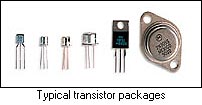Transistors are composed of three parts ' a base, a collector, and an emitter. The base is the gate controller device for the larger electrical supply. The collector is the larger electrical supply, and the emitter is the outlet for that supply. By sending varying levels of current from the base, the amount of current flowing through the gate from the collector may be regulated. In this way, a very small amount of current may be used to control a large amount of current, as in an amplifier. The same process is used to create the binary code for the digital processors but in this case a voltage threshold of five volts is needed to open the collector gate. In this way, the transistor is being used as a switch with a binary function: five volts ' ON, less than five volts ' OFF.
 Semi-conductive materials are what make the transistor possible. Most people are familiar with electrically conductive and non-conductive materials. Metals are typically thought of as being conductive. Materials such as wood, plastics, glass and ceramics are non-conductive, or insulators. In the late 1940's a team of scientists working at Bell Labs in New Jersey, discovered how to take certain types of crystals and use them as electronic control devices by exploiting their semi-conductive properties.
Semi-conductive materials are what make the transistor possible. Most people are familiar with electrically conductive and non-conductive materials. Metals are typically thought of as being conductive. Materials such as wood, plastics, glass and ceramics are non-conductive, or insulators. In the late 1940's a team of scientists working at Bell Labs in New Jersey, discovered how to take certain types of crystals and use them as electronic control devices by exploiting their semi-conductive properties. Reference:
Answered by: Stephen Portz, Technology Teacher, Space Coast Middle School, FL
No comments:
Post a Comment